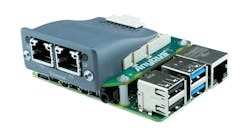Industrial machines and systems that are created for them need to move toward a connected enterprise with a seamless value chain. An interconnected manufacturing value chain working toward demand, visibility and planning, and optimizing production within existing business models, has not yet been affordably and comprehensively achieved.
For the food industry, a primary focus is product quality and food and human safety. The value chain and the speed of information that is needed to go "from farm to fork" or from first concept to the commercialized product is constantly increasing. Machines and systems need to connect in such a way to allow for agile, demand-driven response. A customer-centric perspective requires that our manufacturing enterprise and all of its components have a nimbleness that we've never seen before.
This next-generation manufacturing environment will require data from all machines, suppliers and manufacturers to be integrated into a context that allows decisions to be made that optimize the value chain. This starts with data accuracy. We need to be able to trust all of the data we have, so that we can act on it. Can we? Machine builders and material suppliers, as well as process manufacturers, can create data at an amazing rate. We all have heard of big data and most of us have it, but we need to act on it to get value.
See More: Ever More Data, but Still Cyber Vulnerable
Our challenge is to produce the best quality product in a safe and sustainable manner and at the most competitive costs, delivered at the right time and place, with the assured, sustained support for its lifecycle. This is the comprehensive approach to manufacturing enterprise management, from design to manufacturing to plant operations to value-chain interfaces to enterprise-wide management and optimization, that the Smart Manufacturing Leadership Coalition (SMLC) focuses on. SMLC is a nonprofit, industry-led coalition building a cloud-based, open-architecture platform that integrates existing and future plant-level data, simulations and systems across manufacturing seams and orchestrate business in real time across the enterprise.
Smart manufacturing marries cloud technologies with real-time manufacturing data and operational requirements, making it possible to access new IT technologies, build dynamic enterprise data systems, scale IT infrastructure and manage applications locally. These new cyber capabilities will transform the business and operations in manufacturing to achieve next-generation value chains. Creating agility that significantly increases market and demand response, new product innovation and speed to market and improved manufacturing process and performance are key outcomes that the SMLC drives toward.
Today, everyone relies on core systems to drive the business, but every system requires its own architecture. In most cases, core systems provide capabilities to do certain things and are usually purpose-built. When you look at all of the for-purpose applications needed in a value chain, you soon have a mountain of core systems and supporting architectures. Many times the optimal solution will join or cross these systems. The industry needs an open infrastructure that can stitch disparate systems and seams together to create innovative solutions. These point solutions cry out for a way to connect, collaborate and interoperate to have a comprehensive approach to manufacturing. That's the fundamental challenge in today’s manufacturing space.
Working with customers as a team, machine builders can use the inherent capabilities of the affordable, open architecture, open-access SMLC platform to enable business real-time decisions. Improving customer support, while gaining information, intelligence and knowledge that can drive better performance of their machines in the field and ability to affordably modernize that equipment, while providing insights on new designs, are key benefits for machine builders when adopting an SMLC platform.
Machine builders and manufacturers are aligned on the value of asset lifecycle management. OEMs will affordably be able to knit and orchestrate their current data, systems and predictive maintenance services with the capabilities of their customers in both proprietary and nonproprietary manners with other machine builders. This will allow visibility and transparency of machine and component performance, as well as the impact on production to finally piece together the assets' true performance.
The time is now, but it's going to take a full collaboration across industry to make a connected manufacturing value chain that we all envision to be highly successful for all stakeholders. Partnerships driving the platform’s development are composed of manufacturers, machine builders, manufacturing consortia, third-party integrators, solution providers, universities, government laboratories and agencies.




